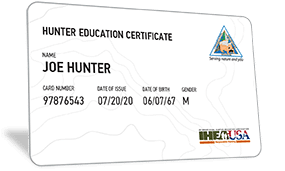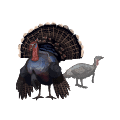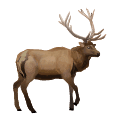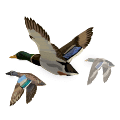
AGE REQUIREMENTS FOR MISSOURI HUNTERS
Every hunter in Missouri who was born on or after January 1st, 1967 is required to complete Hunter Education Certification. Hunters must be at least 11 years of age in order to complete an online course.

MISSOURI HUNTING EDUCATION REQUIREMENTS
WHAT IS A MISSOURI HUNTER EDUCATION CERTIFICATE
A Missouri Hunter Education Certificate proves that you’ve obtained the knowledge needed to hunt safely, responsibly, and ethically, within the state of Missouri. All hunters in Missouri who were born on or after January 1st, 1967 are required to get certified in order to purchase a firearms license within the state.
WHERE CAN I GET MY MISSOURI HUNTER EDUCATION CERTIFICATE?
You can obtain your Missouri Hunter Education Card by completing a Missouri Department of Conservation-approved course. Courses can be taken either online or using a blended learning option, depending on your preference.
Blended Course
The blended learning course option can be completed by all hunters who are 11 years of age or older, and consists of a knowledge sessions, which can be completed online or in-person depending on the student’s preference, followed by a skills session and final exam. The skills sessions must be completed in-person, and students must register to obtain a spot in the session.
Online Course:
Hunters who are 16 years of age or older may choose to complete hunter education certification entirely online. Online courses typically take 4-6 hours to complete, plus quizzes and a final 60 question exam. Upon successful completion of the online course, students will be issued a Temporary Hunter Education Certificate.
HOW OLD DO I HAVE TO BE TO GET A HUNTER EDUCATION CERTIFICATE IN MISSOURI?
You must be 11 years of age or older to complete a hunter education course in Missouri, and obtain a Hunter Education Certificate.
APRENTICE HUNTER PROGRAM
Missouri Apprentice Hunter Program is available to hunters within the state who are 16 years of age or older, who have not obtained hunter education certification. In order to participate in the program hunters must:
- Purchase an Apprentice Hunter Authorization, which is valid for one year
- Obtain a firearms hunting permit (ex. A small game or turkey permit)
- Hunt only while in the immediate presence of a licensed and hunter education adult who is 18 years of age or older (or who was born prior to January 1st, 1976).
Is my Missouri Hunter Education Certificate valid in other states?
The Missouri Hunter Education Certificate will be accepted in any US state, province, or country which also requires mandatory hunter education, meaning hunters who have obtained their Missouri Hunter Education Certificate may use it to hunt in other states. This is known as “reciprocity”.
What's the difference between a Hunter Education Certificate and a Hunting License?
A Hunter Education Card proves that you’ve obtained the knowledge you need to hunt safely and ethically in Missouri, and is different from a Hunting License or permit. The Hunting Licence is similar to a permit, and is required to hunt any game animal within the state. Different licenses and permits may be required depending on which game animal is being hunted.

HUNTING LICENSES, STAMPS AND PERMITS
HUNTING LICENSES
A Hunting License or Permit is required in the state of Missouri to hunt any game animal. There are a variety of permit types available depending on your age, residency status, and what type of game you plan to hunt. Some of the hunting permit types in Missouri include:
Firearms Any-deer hunting permit
This permit allows a hunter to take one antlered or antlerless deer during the legal hunting season. The cost for the permit will depend on the hunter’s age and if they are a resident or non-resident of the state. Youth permits of this type are also available.
Lifetime Conservation Partner Permit
This permit grants a hunter with multiple privileges including the same as those granted with the resident hunting and fishing permit, trout permit, migratory game hunting permit and conservation order permit. Deer and turkey hunting privileges are not included with this permit type and must be obtained separately.
Lifetime Small Game Hunting Permit
This permit grants a hunter multiple lifetime privileges including those granted with the small game hunting permit, migratory bird permit, and conservation order permit. Deer and turkey privileges are not included with this license type. Additionally, a Federal Duck Stamp is still required to hunt waterfowl. Other permit types may still be required.
MISSOURI HUNTER CERTIFICATION AGE REQUIREMENTS

UNDER 10 YEARS OF AGE
Hunters who are 10 years of age or less are permitted to hunt within the state of Alabama, without hunter education certification as long as they are in the immediate presence of an adult hunter who possesses the required permits.

Under 16 years of age:
Hunters who are less than 16 years of age are not required to obtain a Hunter Education Certificate in order to hunt within the state of Missouri until they are ready to hunt alone. Youth hunters who have yet to be certified must be under the supervision of an adult mentor.

11 Years of age or Older
Hunters who are 11 years of age or older, and who were born on or after January 1st, 1967 are required to obtain Hunter Education Certification to hunt within the state. Proof of hunter education must be presented to purchase a firearms license within the state. Some exceptions may apply for hunters who are supervised by a certified adult hunter.

Missouri's Hunting Fines

Hunting without a deer or turkey permit
Up to $285

Hunting without a small game permit
Up to $15

Failure to tag deer when required
Up to $200

Blaze orange violations
Up to $167

Spotlighting an animal when not hunting
Up to $175
MISSOURI HUNTING FAQS
DO I NEED A HUNTING LICENSE TO HUNT WITHIN THE STATE OF MISSOURI?
Yes. A Hunting License is different from a Hunter Education Certificate and is required for any person who hunts any game animal within the state. This includes both residents and non-residents. Varying licenses must be purchased and carried depending on the hunter’s age, residency, and the type of game being hunted. Certain exceptions may apply depending on the game animal being hunted. For more information on Missouri, hunting licenses visit the Missouri Department of Conservation website.
WHAT ARE THE MISSOURI TAGGING REQUIREMENTS?
Certain game animals must be tagged and/or checked after they’re taken, including big game animals such as deer and turkey. It’s important for hunters to understand the tagging and/or harvest reporting requirements for the game animal they’re hunting, and to ensure that the animal is tagged and reported properly.
Tagging Requirements
Immediately after a hunter has taken a deer or turkey the appropriate permit must be notched. Paper permits can be notched or torn to indicate the month and day or the harvest. Permits can also be “notched” electronically using the MO Hunting App.
Once the permit has been properly notched the deer or turkey may be transported within the state. Harvested game animals within the state do not need to be tagged so long as the hunter who took the animal remains with it, but if a hunter leaves the deer or turkey it must be tagged.
To properly tag a taken deer or turkey, attach the notched permit to the deer or turkey’s leg, and (ideally) seal the tag in a waterproof bag (such as a zip-top), and attach the tag with wire or string.
Deer or turkey must also be reported by 10 PM on the day of the harvest, before processing, or before leaving the state (whichever comes first). Deer and turkey can be reported by phone using the Telecheck system, or online using the MO Hunting App.
WHAT ARE THE HUNTER ORANGE REQUIREMENTS IN MISSOURI?
Hunters are required to wear both a hunter orange hat and hunter orange shirt, best or coat, which is plainly visible from all sides under the following conditions:
- Hunting any game species during the deer firearms season
- Hunting elk or accompanying an elk hunter during the firearms elk season
- Hunting in any area while a managed firearms deer season is taking place
- When serving as a mentor to another hunting during a firearms deer season or within an area where a managed firearms deer season is taking place
Hunter orange exceptions:
Hunters orange is not required during the deer firearms season, or in an area which is having a managed deer firearm hunt, or during the firearms elk season under the following conditions:
- Hunting migratory game birds
- Hunting with archery equipment within municipal boundaries where the discharge of firearms is prohibited
- Hunting on federal or state land where deer hunting in restricted to archery method
- You are using an archery permit during the alternative methods portion of the season
- You are hunting in a county that is closed during the antlerless deer portion of the season
- Hunting small game or furbearers during the alternative methods portion of the season
- When hunting small game or furbearers during the firearms portion of the elk season
WHAT ARE THE BAG LIMITS IN MISSOURI?
Bag limits are imposed on hunters to restrict the number of a particular game animal that can be taken. Bag limits may be daily or seasonal depending on the type of animal. For example, daily bag limits may be imposed which restrict the number of a particular game animal that may be taken in a single day. Seasonal bag limits restrict the number of a particular game animal that may be taken by a hunter within the hunting season.
Bag limits may vary annually depending on game species populations. Hunters must understand and follow bag limit restrictions. Violations may result in fines. For more information on bag limits visit the Missouri Department of Conservation website.

GAME AND NON-GAME SPECIES
GAME SPECIES
Missouri offers a wide variety of game species for all types of hunters. With its low lying flats and plains, and mountainous ranges the state’s diverse landscapes and habitats are home to diverse wildlife populations and plenty of game species.
Game species in Missouri include:
- Big game including white-tailed deer, elk, and turkey.
- Small game including dove, rabbit, quail, pheasant, and squirrel.
- Waterfowl and other migratory game birds including ducks and geese.
- Furbearers including beaver, bobcat, fox, and coyote among others.
NON-GAME SPECIES
Nongame species within the state make up a majority of Missouri’s wildlife and include mammals, birds, fish, reptiles, amphibians, and invertebrates which typically may not be hunted, are considered a nuisance, or are protected, endangered, or at risk. There is, unfortunately, a lengthy list of endangered, protected, and threatened species within the state. For more information on nongame, and endangered species within the state visit the Missouri Department of Conservation website.
INVASIVE SPECIES
Invasive animals and other pests have been introduced to the United States, including the State of Missouri, and have become a threat to native wildlife. These animals, plants, fish, and invertebrates typically have no natural predators which can result in the rapid spread and population growth. This in turn can seriously harm the state’s lands and waters and can be detrimental to the health and population numbers of a variety of the state’s native plants and animals. Some common invasive species in Missouri include the Asian longhorn beetle, emerald ash borer, European woodwasp, as well as the Feral Hog – one of the most destructive and notable of the state’s pests.
In order to protect Missouri’s native plants and animals, invasive species must be controlled and eradicated. Anyone who encounters or suspects that they have encountered an invasive species within the state is encouraged to report the sighting so that it can be monitored and controlled. For information on how to report various types of invasive species in Missouri visit Missouri’s Department of Conservation Invasive Species page.

MISSOURI HUNTING SEASONS
Hunting seasons and dates may change annually per game animal, depending on a variety of factors. Season dates are further broken out, region or zones. Additionally, seasons are often categorized by firearm time, including archery, firearms, and muzzleloader or “primitive” firearms seasons.

Deer
Deer seasons in Missouri are organized by firearm type (ex. Archery vs. firearms), and dates may vary depending on the hunter’s age as well as the type of deer (antlered vs. antlerless). Seasons dates typically begin in September with an Archery season, with later seasons ending in January of the following year.

Turkey
Turkey hunting seasons in Missouri are organized by firearm type and include both a fall and winter season. The fall season typically begins in September and ends in January of the following year, while the spring turkey season begins in April and ends in May.

Elk
Elk seasons in Missouri are organized by firearm type and tend to be shorter than those of other game species. Elk seasons typically only run for a period of two weeks, with a 2-week season in October and another in December.

Waterfowl
Waterfowl seasons in Missouri vary depending on the waterfowl species (ex. Ducks vs geese etc.). Seasons are further organized by hunting “zones” or regions within the state. Waterfowl seasons typically begin as early as September, depending on the seasons, with later seasons ending in February of the following calendar year.
HUNTING ON PUBLIC OR PRIVATE LAND
PRIVATE LAND
Much of the land in Missouri is privately owned. Hunters can typically freely take game animals hunted on their own private property, or may seek permission from a landowner to hunt on private property. Hunters who wish to take game on privately owned land must follow state hunting regulations as well as any regulations specified by the landowner. Hunters must ensure they respect the rights and property of the landowner at all times.
MISSOURI RECREATIONAL ACCESS PROGRAM
Missouri’s Outdoor Recreational Access Program was developed to provide more outdoor recreational opportunities within the state. The program provides annual incentive payments to private landowners who open their land for public recreational activities. Many of these lands are open to public use for hunters, in addition to anglers and wildlife viewers.
Interested landowners who own at least 40 acres of land can participate in the program. For more information on the Outdoor Recreational Access program visit the Missouri Department of Conservation website.
PUBLIC LAND
There are hundreds of thousands of acres of public hunting spaces across the state of Missouri including Conservation Areas, Recreational Access Program areas, wildlife refuges, state parks, and forests. Some of these areas are also open to a variety of outdoor recreational activities including hiking, bird and wildlife watching, and camping, among others.
Public hunting areas within the state encompass a wide variety of habitats and diverse natural areas, which result in a wide variety of wildlife and wild game species. Hunters should keep in mind that hunting and recreational use regulations may vary within the spaces. Hunters must follow the regulations within the particular area – this may include firearm type restrictions, road closures, and other restrictions for hunters and/or recreational users.
For more information on public hunting access within the state of Missouri, visit the Missouri Department of Conservation website.
Conservation Areas
Hunting in Missouri’s Conservation Areas
The Missouri Department of Conservation manages the state’s Conservation Areas. These are designated land spaces which are managed to ensure sustainable population growth of game species and habitat management. There are nearly 1,000 state-managed Conservation Areas through Missouri which are open to public hunting access. The lands may also be used for other recreational purposes including hiking, and wildlife or bird watching, among others.
These lands are home to numerous game species including white-tailed deer, turkey, and waterfowl as well as game birds and small game species including quail, pheasant, doves, and rabbits.
Hunters should also keep in mind that special regulations may apply to hunters within these areas. To learn more about Conservation Areas in the state of Missouri, visit the Missouri Department of Conservation website.
Conservation Area Regulations
Certain additional regulations may apply to hunters and other Conservation Area land users. Specifical regulations will vary depending on the Conservation Area. For specific regulations, visit the Missouri Department of Conservation Conservation Area Regulations page, and choose the conservation Area you plan to visit to see the regulations that apply within the area.
Conservation Area Permits
There are no specific additional permits required to hunt within Missouri State Conservation Areas, however regular permits and licenses are required based on the game species you plan to hunt.
The Show-Me State. Ready and rarin’ to go.

Where to Hunt in Missouri
With millions of acres of lands open to public hunting, and numerous game species, Missouri has a wide variety of hunting destinations to choose from. Whether you’ll be hunting public or private land, you’re sure to find the perfect spot to hunker down in a blind or stalk through the woods to find your prey.
Top hunting spots throughout the state will depend on your game animal of choice. If you’re in search of top spots for trophy buck, you’ll find some prime locations within Callaway County and Chariton County – both boast multiple Boone and Crocket record book entries for records bucks. Nearby Conservation Areas include Whetstone Creek and Yellow Creek.
Turkey hunters should head to the Harry S. Truman Reservoir Management Lands, located in the west-central region of the state, this land surrounds the Harry S. Truman Reservoir and consistently reports high turkey harvests. Hunters headed to the area should note that much of the acreage is accessible only by foot, or boat, so check out maps of the area before you head out.
If you prefer a flightier bird head for the states wetland regions and lakes for prime waterfowl hunting. Top spots for these feathered game animals include Truman Lake and Otter Slough Conservation Area.